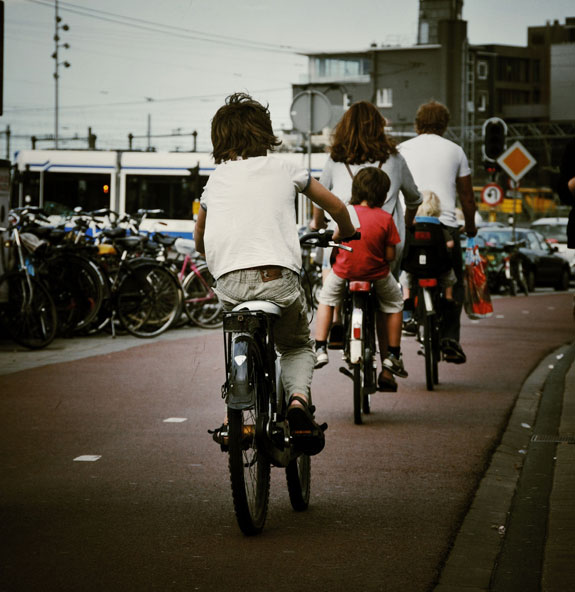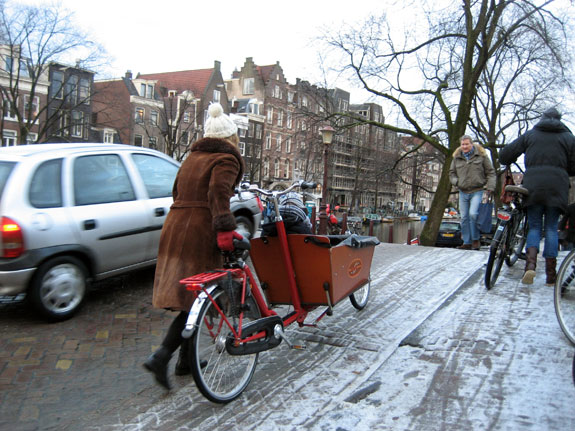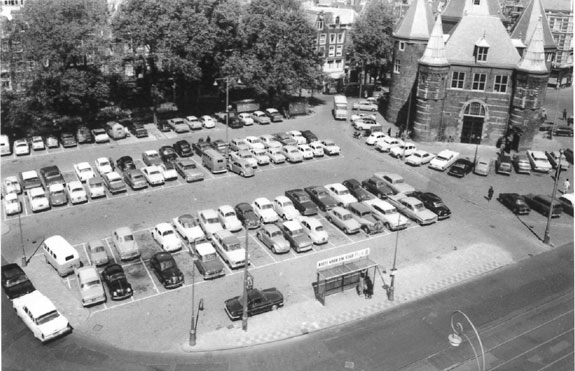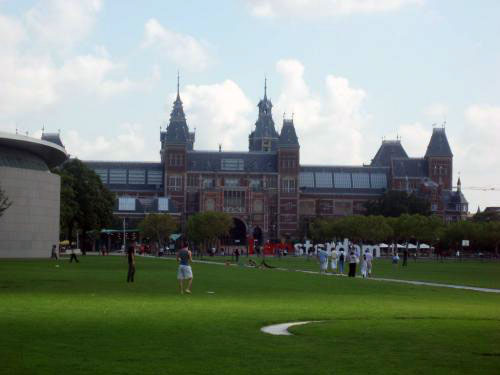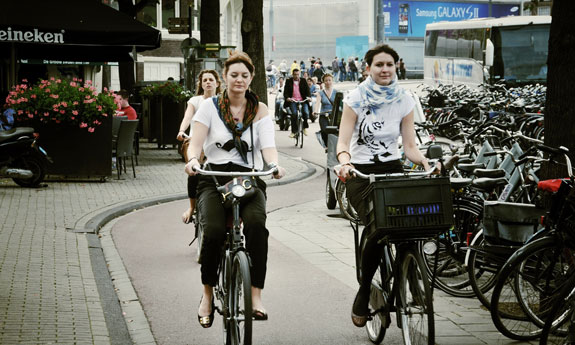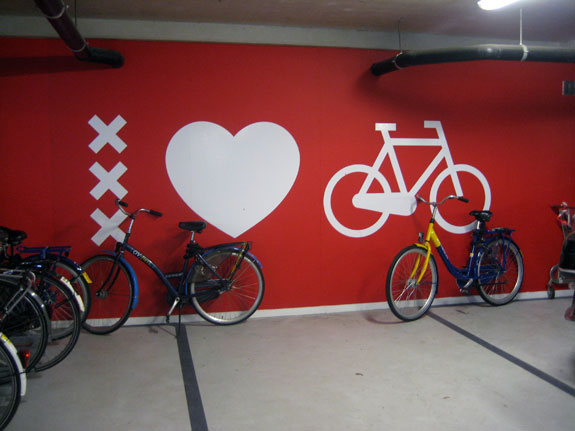Lessons from Amsterdam: How SF Can Bicycle Toward Greatness
8:53 AM PDT on September 19, 2011
It’s not often that you get to take your idea of utopia out for a test ride. But that’s what I was lucky enough to do for seven months last year while on sabbatical in Amsterdam.
After more than a decade of helping to build the vision of San Francisco becoming a world-class bicycling city, I had the chance to find out how that vision actually functions on the ground. And, to assess whether we really have what it takes in San Francisco to earn the reputation of a great bicycling city.
What I learned – and what heartens me now – is how close we already are. Much like Berlin, Barcelona, and Paris, San Francisco is on a precipice today. We can choose to use the examples of places such as the Netherlands as a model, or we can continue business as usual.
This week, we are fortunate to welcome Dutch experts to town to show us how great bicycling environments help make great cities. Think Bike — an innovative two-day event co-sponsored by the Consulate General of the Netherlands in SF, the SF Municipal Transportation Agency, and the SF Bicycle Coalition — kicks off today to share the “Dutch Touch” with San Franciscans.
“Whether commuting to work, running errands or taking a family outing, more and more San Franciscans are choosing to bicycle,” said Mayor Edwin M. Lee, who this morning will welcome skilled Dutch transportation planners and interested locals at City Hall for the opening reception of Think Bike. This will kick off two days of intensive planning workshops with the Dutch and local community members. Tuesday evening, their design ideas for specific San Francisco on-street and policy improvements will be shared publicly.
“We know that improvements to San Francisco’s bike network encourage bicycling citywide,” said Edward D. Reiskin, SFMTA Director of Transportation. “We look forward to collaborating with our Dutch colleagues and City partners on creative solutions to help keep the number of bicyclists growing in the years ahead.”
This week’s Think Bike events, which are happening in cities around the U.S., are part of a growing interest among S.F. leaders to partner with experts from the Netherlands to find ways to keep up with the large and growing demand for better bicycling in San Francisco, where polls show that a majority of residents already bicycle occasionally and want to bicycle more often.
Last year, a group of city leaders from the Bay Area — including SF Board of Supervisors President David Chiu and SFMTA Director (then SF Dept. of Public Works Director) Ed Reiskin — traveled to the Netherlands on a study trip organized by Bikes Belong. There they had the chance to see first-hand how seamlessly the bicycle is incorporated into Dutch life, with bicycles routinely used for commuting, shopping, recreation and exercise.
As we embark on a week of benefiting from the Dutch Touch, and as I reflect back on my own bicycling experiences in the Netherlands, I am by no means calling for San Francisco to be just like Amsterdam. We cannot and should not try to replicate any other city completely.
But I learned that this surprisingly similar city offers a strikingly fitting model for us right now. The story of Amsterdam is proof that cities of San Francisco’s size, density and values can create communities that are more accessible, affordable, and family-friendly by dramatically increasing bicycling trips.
A Tale of Two Cities: Amsterdam & San Francisco
There is no city in the world where such a large portion of the population rides bicycles for transportation. Citywide, 38 percent of trips are made by bikes in Amsterdam. In the more compact city center, that number leaps to 57 percent.
Each day, the people of Amsterdam ride more than a million miles on their bicycles. They boast 250 miles of separated bike paths and 250,000 designated bike parking spaces. As bicycling has increased, car ownership has decreased. Today, only 37 percent of the population owns cars, a decrease from 42 percent in 1985. And, transit makes up about 25 percent of trips.
The real-life impacts of these statistics can be seen every day on the charming streets, where parents still allow kids to walk or bike home from school and the elderly pedal around confidently on errands. No doubt, the streets are just as bustling and serve just as many people moving around the city as in San Francisco – it is all just happening in a calmer, quieter, less disruptive way in Amsterdam.
Some may question, understandably, whether a centuries-old European city can be relevant to our situation. In fact, Amsterdam offers a surprising number of similarities to San Francisco, which is considered the most European of U.S. cities for good reason. A quick comparison sheds some light:
- Amsterdam’s population is 765,000. San Francisco is slightly more populous at 815,000. Both serve as hubs of far larger metropolitan regions.
- The two cities have similar population density: Amsterdam boasts 390,000 dwelling units; San Francisco 360,000.
- Unlike their suburban neighbors, most streets are narrow and space is at a premium.
- Finance and tourism are backbones of both cities’ economies.
- While Amsterdam’s regional transit far outpaces the Bay Area’s, neither has top-notch local transit systems.
- Citizens share similar cultural attitudes about the environment and general progressive values, relative to the rest of their own nations’.
- Both have higher-than-average citizen participation, which affects how changes are made in the communities.
The two cities’ most obvious difference is terrain. Amsterdam is as famous for flatness as San Francisco is for hilliness. Yet, I contend that in San Francisco we narrow that disadvantage with gears (almost non-existent in Amsterdam), bike racks on buses, and, the fact that most of us can choose to pedal around, instead of straight up, steep hills for many trips.
Another well-known difference is weather, but this one works in our favor. I was amazed that the number of people pedaling nonchalantly over freshly fallen snow in Amsterdam easily rivals our warmest day in San Francisco. The Bay Area’s near-ideal, temperate climate would surely win out over Amsterdam’s Boston-like winters and Portland-like rain for great bicycling.
Of course, there are other serious differences. These include forward-thinking Dutch laws that place greater liability in collisions on those driving, leveling the playing field for more vulnerable road users. Another difference is that far fewer individual garages and curb cuts exist in Amsterdam, which means fewer areas of conflict. And, of course, higher gas taxes across Europe demonstrate their commitment to showing the true cost of driving while also effectively encouraging more sustainable modes. This is a far cry from American gas subsidies.
Despite these advantages, I believe that none is absolutely critical to our own progress in San Francisco, given the strong demand for better bicycling.
But what about the historical and cultural differences? Haven’t the Dutch always been bicycling? If it is simply in their blood, how can we, as car-loving Americans, expect to learn from them?
This is where my eyes were opened the most during my time abroad, and what has me feeling most encouraged today.
Sure, it is true that the Netherlands boasts a deeper culture and longer history of bicycling for transportation, but it is also true that many of their bicycling innovations and successes have come relatively recently — and under quite similar circumstances that we are experiencing in San Francisco today.
The arc that we are on in San Francisco right now is surprisingly akin to that of Amsterdam 40 years ago when engaged citizens led by passionate advocates convinced local leaders to solidly commit to making bicycling the easiest and most favored way to get around the city. And they succeeded.
This is Amsterdam’s bicycling story. It’s a history we can and should relate to today if we want to make San Francisco more accessible, more family-friendly, and more welcoming for local businesses.
The Story of Amsterdam: You May Be Surprised
At the turn of the 20th century, bicycling for transportation was common through much of Europe. But after WW II, as automobiles gained popularity and more city-planning decisions favored driving, bicycling grew less common.
Even within Amsterdam, there was a shift toward car predominance. Streets were widened and sidewalks shrunk. On-street car parking was added nearly everywhere it could be squeezed in, even on some of the most picturesque and formerly thriving pedestrian areas.
For example, the large, historic square at Neiuwmarkt in front of the 17th-century Waag, which served over the centuries as a weighhouse and central meeting area was transformed into a surface parking lot during the 1960s.
Another poignant example is the well-known Museumplein. Today it is a grand and popular grassy commons boasting the grand Rijksmuseum and other world-famous museums, shops, and high-end residences.
I was shocked to learn that, until the 1970s, a major auto roadway ran directly under the Rijksmuseum (today, it is a bike-only pathway under a grand archway) and straight thru the now-grassy commons. It’s hard to imagine this today, considering how well-loved the pedestrian-only area is now.
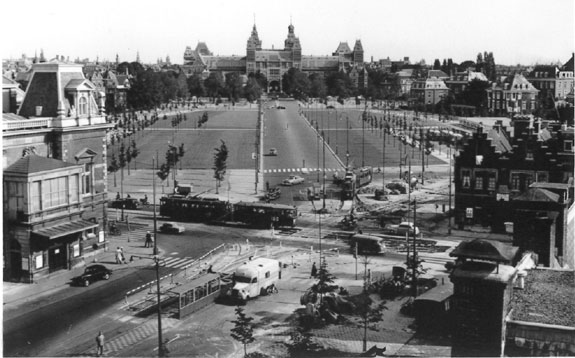
As recently as the late 1970s throughout Amsterdam, the streets little-resembled the bike-friendly places we see now. Today, a walk over one of the famously quaint canal bridges offers picturesque views with unparalleled photo opportunities. Forty years ago, those same bridges were choked with car traffic and filled with car parking.
And in countless places where today you can ride on bike paths that are fully separated from car traffic and with bike-specific traffic lights, just 10 years ago there were no bike paths, no bike signals, far fewer bicycles, and significantly more cars.
Not surprisingly, this crumbling bicycle environment contributed to a precipitous drop in the number of people bicycling. In 1955, 75 percent of all trips in Amsterdam were made by bicycle. By 1970, that number had declined to only 25 percent.

Shifting the Paradigm Toward Sustainable Transportation
In the 1970s, Amsterdammers grew increasingly concerned about the environment and the oil crisis – as well as overall city livability, traffic, and noise. It all came to a tumultuous head as planners and government officials attempted to plow ahead with increasingly unpopular projects, including one to replace a beloved part of the historic city center with a new freeway.
Enough was enough. Starting in the 1970s, citizens and newly formed advocacy groups such as Fietsersbond, (a membership-based nonprofit similar to the San Francisco Bicycle Coalition), began to work to return their city streets to safety and community.
They stopped the unpopular freeway plan. They replaced car parking lots in public squares with pedestrian-only public squares. Today, for example, the Neiuwmarket boasts a buzzing outdoor market and dozens of restaurants and bars, popular with tourists and locals alike. Walking through the thriving, pedestrian-only area now, it is hard to imagine that it was once covered with parked cars and would have been wiped out by the proposed freeway.
Most notably to Amsterdam’s long-term progress, in 1978 a new City Council was elected who heard and responded to the citizens’ outcry for a more livable and environmentally responsible city. The Council began markedly prioritizing bicycling, walking, and transit trips over automobile trips.
On-street car parking was converted to new bike paths and wider sidewalks. Colored bike lanes were painted on streets that couldn’t fit separated pathways. “Stop” lines for drivers were pushed back to make room for colored bike boxes. Bicycle-specific traffic lights were added at hundreds of intersections. Many dozens of “traditional” streets in shopping districts were turned into bike- and pedestrian-priority corridors, boosting business. Speed limits were lowered. Traffic-calming speed humps and traffic circles were added.
The City Council’s commitment continues today and is working. The number of people biking in the past 20 years alone has increased by more than 20 percent.
And this is the chief reason I contend that we should feel encouraged in San Francisco: Amsterdam’s reputation as a bicycling mecca is, largely, the result of work undertaken in just the past few decades. That is a tremendous amount of progress in a relatively small amount of time. That’s inspiring to me. Because if they could do it then, we most certainly can do it now … perhaps even better.
The Choices are the Same, Whether in Europe or America
But how did Amsterdam keep progress rolling beyond the early days of passionate rallies, of which San Francisco has experienced its fair share. How did the view that bicycling should take predominance over driving move from words to action? And how did it then develop into long-term, government-led commitment?
A key difference seems to be this: In Amsterdam, local elected leaders have not only explicitly acknowledged the tremendous health, environmental, equity, and livability benefits of biking over driving – as San Francisco leaders have too – but they have also gone a critical step further. Based on their commitment to these benefits, Dutch leaders across the nation have developed clear and consistent policy that it should be easier to bicycle, walk, and take transit in the city than to drive for most trips. And, they act based on that policy.
It is understood that the challenges to making the city more bicycle- and people-friendly are predominantly political challenges – not physical ones – and progress requires sometimes-tough political choices. This means that local electeds set the policy and direct transportation officials within the bureaucracy to carry that policy out, even if it means occasionally upsetting some people who will not be able to drive or park as easily as they once did.
And this is where San Francisco – and the rest of America – still have a lot to learn.
If We’re Really Serious About This….
Politically, it may be advantageous to talk about “balance” and to try to squeeze better biking, walking, and transit into the left-over margins, but to actually make our city more accessible and safe, and less traffic-choked, we need to adopt and stick to a policy that helps make it easier to bicycle, walk, and take transit in our city than to drive – at least for most people for most trips.
I was able to see example after example of Amsterdam planners and politicians making it easier and more convenient to ride a bicycle while making it just a little less convenient — though by no means impossible — for those who need to drive.
None of this means that people are not allowed to drive a car in Amsterdam. It just means that people may drive on streets that are narrower in order to make room for new bike paths, and that they must go slower (improving safety for all, including drivers). Sometimes they may need to travel a block or two out of the way, but can always get where they want to go.
An example is Staalstraat, a central street that runs directly in front of the shared City Hall/Opera/ Ballet building and along the beautiful Amstel River and near a major Metro station and outdoor market. This used to be a traditional, two-way street with cars until a few years ago, when it was converted to a two-way bicycle-only path with a wide sidewalk next to it.
Today it is a well-used and lovely part of the city, drawing far more people bicycling and walking than before. People who are driving can still reach the nearby underground garage but they take slightly different routes. It may take them a minute or three longer to drive there, but people are still attending operas and ballets and visiting City Hall.
How Do We Pedal Forward?
As in Amsterdam, it is clear that San Francisco, too, loves bicycling. Seven out of 10 San Franciscans ride a bicycle occasionally. And polls show they want to ride more often.
Most trips within San Francisco are 5 miles or less. These are eminently bikeable trips for many people. And we are seeing far more people choose to bicycle – lawyers and architects riding downtown to work, parents bicycling their kids to school or day care in the mornings, friends riding together to dinner or a show.
To improve, we need to build on our many successes and speed up the rate of change. Events like Think Bike this week highlight our political leaders’ growing interest to look outside of the American box for great transportation models.
I challenge our decision makers to take advantage of the growing public appetite to try new approaches on our streets and to not be constrained by American examples.
If San Francisco is to be the U.S. leader as a great bicycling city, we must hasten the pace of change. I urge the City to look to popular visions like the San Francisco Bicycle Coalition’s Connecting the City, as a way to make our streets welcoming for all who want to try bicycling, from ages 8 to 80.
Just as the Netherlands used a time of crisis in the 1970s to spur positive change, let us consider today’s urgent situation of shrinking government budgets and increasing strains on the transportation system as an opportunity to think differently.
Today, we are a good bicycling city. We have it in us to become a great bicycling city.
Stay in touch
Sign up for our free newsletter
More from Streetsblog San Francisco
Streetsblog SF editor Roger Rudick offers constructive criticism of Chicago’s downtown bike network
"There were blocks that felt very safe and very secure," he said. "But then you're immediately – voom! – disgorged into three lanes of moving traffic with no protection."
Commentary: There is Zero Ambiguity to the West Portal Tragedy
What happened in West Portal was entirely predictable and preventable. The city must now close Ulloa to through traffic and make sure it can never happen again

